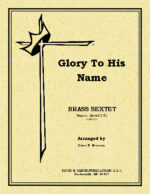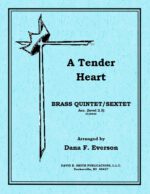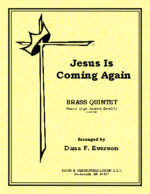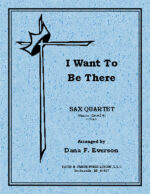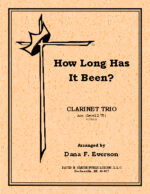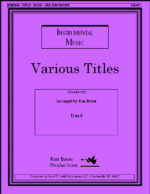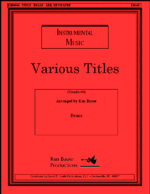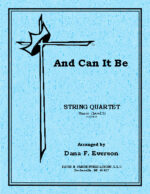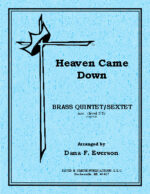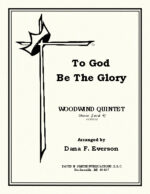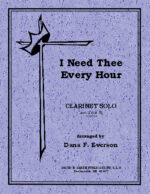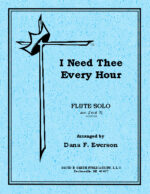-
Glory To His Name
$12.00This brass sextet is score for 2 trumpets, horn (opt. Trp.), trombone, baritone and tuba. Essentially in an ABA song form this march-style piece has a beautifully constructed expressive section in the middle.
-
Will Jesus Find Us Watching
$12.00The piece starts out with a reflective feeling- challenging the though of the title. But all of a sudden it breaks out with a sense of resolve as if the questions has been answered. This resolve is present in many different ways, compositionally, until it builds to a final, determined resolve!
-
Now I Belong To Jesus
$11.00This brass quintet is scored with traditional instrumentation along with an optional trumpet part. The pieces is presented in a simplistic manner giving over to many opportunities for great expression. It is an intimate rendition of a reflection song.
-
The Heavens Declare
$13.00This Ron Hamilton quintet/sextet has a march like flavor with a great deal of moving accompaniment lines. The style is maintained throughout while going through various key and dynamic changes.
-
How Majestic is Thy Name
$12.00This Ron Hamilton song is beautifully arranged for brass quintet with optional horn (trp) and trombone (BHTC) starting out in a strong flowing manner. It continues with gentle harmonic patterns using suspensions, metrical and key shifts to give a sense of musical flow. It ends on a high note with more force to exemplify the idea od Majesty.
-
The Joy Of Jesus
$12.00This brass quintet with optional baritone TC part has a light texture throughout with tasteful pointal additions. It often uses expressive duet lines as it moves amongst the various voices. After a couple modulations always moving upward it comes to a final strongly stated conclusion.
-
A Tender Heart
$12.00This quintet (opt. Sextet) begins in a plaintive fashion with block harmonic structure in the lower voices. The tune is presented in the trombone and after picked up in the first trumpet. A modulation takes place and the second trumpet carries the tune. The final section allows the low voice to carry the theme where the ending is solemn built on a simple motif.
-
Jesus Is Coming Again
$13.00A traditional brass quintet there are optional parts for a sextet. The arrangement starts out rather solemnly and gains strength and elevation as it progresses, ending with an uplifting and solid statement.
-
Come Thou Fount
$12.00This piece is scored for traditional brass quintet with optional third trumpet. The piece makes melodic statements while moving through several different key centers. It is rich with contrapuntal accents.
-
I Want To Be There
$10.00Delightful! Delightful! Delightful! The style of this work just makes it a continual joy! The whole first section features the lead sax with chromatic underpinnings. The interlude features the tenor line at a slower pace and then the whole thing erupts into the joyous feelings of the first section. It then catapults into a punctuated ending making a final statement.
-
How Long Has It Been
$8.50A trio that exudes a gentleness and tenderness from beginning to end. The melodic lines are mildly altered and the support harmonies and counterpoint move in a way that gives a sense of direction to the future. A very affective piece.
-
How Long Has It Been
$8.50A trio that exudes a gentleness and tenderness from beginning to end. The melodic lines are mildly altered and the support harmonies and counterpoint move in a way that gives a sense of direction to the future. A very affective piece.
-
Fantasy On A Scandinavian Hymnsong
$60.00Arranged on “Built on the Rock….” beginning with chime followed by clarinet & bass clarinet, then a horn solo. The melody is passed between sectionsthen a quiet tranquil fugato. Concluding by an eternal sound crafted on organum harmonies.
-
All Hail The Power Of Jesus’ Name
$5.95solo with piano. This beloved, timeless hymn is arranged at the grade 2.5 level yet is crafted with expressiveness and balance that sounds like a much more advanced performance level than grade 2.5. Both the soloist and piano accompanist are featured.
-
And Can It Be
$10.00This is a traditional string quartet with optional third violin. The melodic material is passed through the various ensemble parts and the textures vary greatly with even a brief fughetta section.
-
Heaven Came Down And Glory Filled My Soul
$13.00This traditional brass quintet has optional parts for trumpet and baritone and can be used as a sextet as well. The piece is presented in a rather straight forward fashion passing the tune around the ensemble for color and interest.
-
My Hope Is In The Lord
$9.00An accompanied brass trio comprise of two trumpets and a trombone, with optional horn and baritone TC parts. After a brief introduction, the parts all join in solid three part harmony in march-like rendition with the piano adding little touches of gaiety. The next section allows the trombone to carry a modified tune with the other voices giving their voices of little statements. With a modulation taking place the second and third voices play an expressive duet, until the first trumpet joins to play an established trio style line. The final measures join the whole group in together for a grand finale.
-
To God Be The Glory
$11.00Scored for traditional woodwind quintet with optional flute, alto sax and bass clarinet parts. The piece is presented in a cheerful manner from beginning to the end. It uses a variety of rhythmic patterns to drive the vitality and joy while moving amongst the various voices which is intended in the title. It ends in a gentle chord of repose.
-
A New Name In Glory
$5.50Beginning in an animated and cheerful manner, the melody is continually altered in obligato-like fashion. The middle section is slower and thoughtful, only to recapitulate to the beginning cheerfulness.
-
A New Name In Glory
$5.50Beginning in an animated and cheerful manner, the melody is continually altered in obligato-like fashion. The middle section is slower and thoughtful, only to recapitulate to the beginning cheerfulness.
-
A New Name In Glory
$5.50Beginning in an animated and cheerful manner, the melody is continually altered in obligato-like fashion. The middle section is slower and thoughtful, only to recapitulate to the beginning cheerfulness.
-
Sunday School Classics
$14.95solos and/or duets in any instrument combination with CD accompaniment. Piano accompaminet is product #44004310
-
Sunday School Classics
$14.95solos and/or duets in any instrument combination with CD accompaniment. Piano accompaminet is product #44004310
-
Sunday School Classics
$14.95solos and/or duets in any instrument combination with CD accompaniment. Piano accompaminet is product #44004310
-
Sunday School Classics
$14.95solos and/or duets in any instrument combination with CD accompaniment. Piano accompaminet is product #44004310

